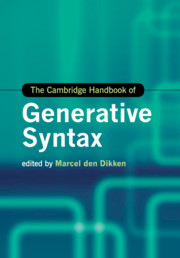Crossref Citations
This Book has been
cited by the following publications. This list is generated based on data provided by Crossref.
Adger, David
2015.
Syntax.
WIREs Cognitive Science,
Vol. 6,
Issue. 2,
p.
131.
2016.
Natural Language Processing and Computational Linguistics 1.
p.
245.
van Rijt, Jimmy
and
Coppen, Peter-Arno
2017.
Bridging the gap between linguistic theory and L1 grammar education – experts’ views on essential linguistic concepts.
Language Awareness,
Vol. 26,
Issue. 4,
p.
360.
Khakimova, Alina I.
Cindori, S.
Larouk, O.
Malushko, E.Yu.
Rebrina, L.N.
and
Shamne, N.L.
2018.
Diachronic Analysis of English Syntax in Relation to Newspaper Style.
SHS Web of Conferences,
Vol. 50,
Issue. ,
p.
01217.
Kimmelman, Vadim
2018.
Basic argument structure in Russian Sign Language.
Glossa: a journal of general linguistics,
Vol. 3,
Issue. 1,
De Fina, Anna
and
Georgakopoulou, Alexandra
2020.
The Cambridge Handbook of Discourse Studies.
Ahmadian, Mohammad Javad
and
Long, Michael H.
2021.
The Cambridge Handbook of Task-Based Language Teaching.
Ayres-Bennett, Wendy
and
Bellamy, John
2021.
The Cambridge Handbook of Language Standardization.
Ryding, Karin
and
Wilmsen, David
2021.
The Cambridge Handbook of Arabic Linguistics.
Silva Garcés, José
and
Espinosa, Gonzalo
2023.
On the Nature of Verbal Non-Local Doubling in Patagonian Spanish.
Languages,
Vol. 8,
Issue. 4,
p.
255.





